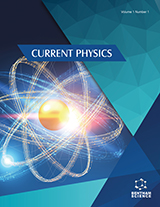Abstract
Background: Calculations of the solar modulation parameter (φ) over the past millennia typically use the relationship between the production rate of cosmogenic isotopes, the earth's dipole moment, and the magnitude of φ. The cosmogenic isotopes 14C and 10Be are typically used in these studies. When studying solar modulation, the cyclic change in dipole tilt is usually not taken into account, which affects estimates of past solar activity.
Methods: Tree rings are a reliable basis for obtaining a radiocarbon time scale (IntCal13). However, determining the concentration of 14C in tree rings is a difficult and controversial task. The time scale derived from the 10Be production rate simulation (GICC05) is less reliable. Nevertheless, there is a way to combine the accuracy of the radiocarbon time scale with the reliability of estimates of the 10Be production rate. This method is the synchronization of the radiocarbon and beryllium-10 series.
We have selected the most relevant methods for calculating the solar modulation parameter φ for the Holocene. When calculating φ, 10Be data synchronized with 14C data were used. The latest data on the earth's dipole moment were considered. Empirical Mode Decomposition (EMD) was used in the analysis of φ.
Results: It has been shown that the first two decomposition modes are oscillating components with periods of 710 and 208 years, the amplitudes of which increase with time, reaching a maximum of 2500 BP. From contemplation, it follows that the 710-year oscillations are apparently caused by fluctuations in the tilt of the earth's dipole. After excluding the EMD component associated with the 710-year cyclicity, a corrected series was obtained for the solar modulation parameter, free from the influence of changes in the tilt of the magnetic dipole.
Conclusion: The rate of formation of cosmogenic radionuclides depends on the intensity of penetration of Galactic Cosmic Rays (GCRs) into the earth's atmosphere. Before reaching earth, GCRs must cross the heliosphere, where they are exposed to solar modulation. Adequate consideration of solar modulation parameters is important for the correct interpretation of the rate of production of cosmogenic isotopes and solar activity.
[http://dx.doi.org/10.1023/A:1016266801300]
[http://dx.doi.org/10.1023/A:1005007527816]
[http://dx.doi.org/10.1126/science.192.4245.1189] [PMID: 17771739]
[http://dx.doi.org/10.1126/science.1065680] [PMID: 11739949]
[http://dx.doi.org/10.1023/A:1026536226656]
[http://dx.doi.org/10.1016/0032-0633(65)90131-5]
[http://dx.doi.org/10.1086/149822]
[http://dx.doi.org/10.1029/JA074i021p04973]
[http://dx.doi.org/10.1029/2003JA010098]
[http://dx.doi.org/10.1029/2009JD012557]
[http://dx.doi.org/10.1016/j.epsl.2011.10.031]
[http://dx.doi.org/10.5636/jgg.34.39]
[http://dx.doi.org/10.1046/j.1365-246x.2000.00011.x]
[http://dx.doi.org/10.1029/2007GC001893]
[http://dx.doi.org/10.1016/j.epsl.2008.04.048]
[http://dx.doi.org/10.1029/2004GC000801]
[http://dx.doi.org/10.1016/j.epsl.2016.08.015]
[http://dx.doi.org/10.1016/j.quascirev.2014.08.017]
[http://dx.doi.org/10.1029/1998JD200091]
[http://dx.doi.org/10.1016/j.epsl.2010.01.011]
[http://dx.doi.org/10.1029/2005JA011500]
[http://dx.doi.org/10.1016/j.quascirev.2006.07.012]
[http://dx.doi.org/10.5194/astra-4-1-2008]
[http://dx.doi.org/10.1073/pnas.1118965109] [PMID: 22474348]
[http://dx.doi.org/10.5194/cp-9-1879-2013]
[http://dx.doi.org/10.1016/j.jastp.2018.10.005]
[http://dx.doi.org/10.1098/rspa.1998.0193]
[http://dx.doi.org/10.1017/RDC.2021.63]
[http://dx.doi.org/10.1016/j.epsl.2011.09.030]
[http://dx.doi.org/10.1186/BF03352849]
[http://dx.doi.org/10.1007/BF00648343]
[http://dx.doi.org/10.1086/160554]
[http://dx.doi.org/10.1029/97JC01282]
[http://dx.doi.org/10.1017/S0033822200032999]
[http://dx.doi.org/10.1029/2004JA010685]
[http://dx.doi.org/10.1016/j.pepi.2008.01.007]
[http://dx.doi.org/10.1134/S0016793221080132]
[http://dx.doi.org/10.1134/S0016793222070155]


















